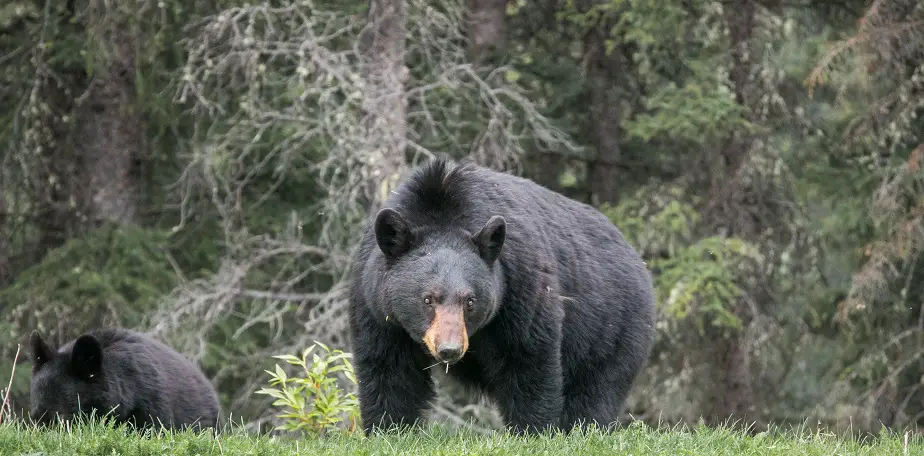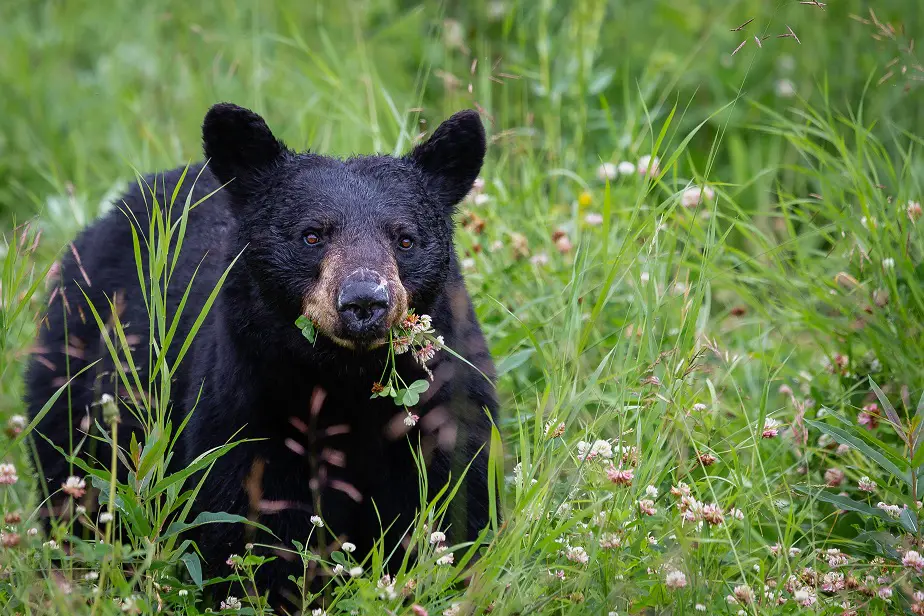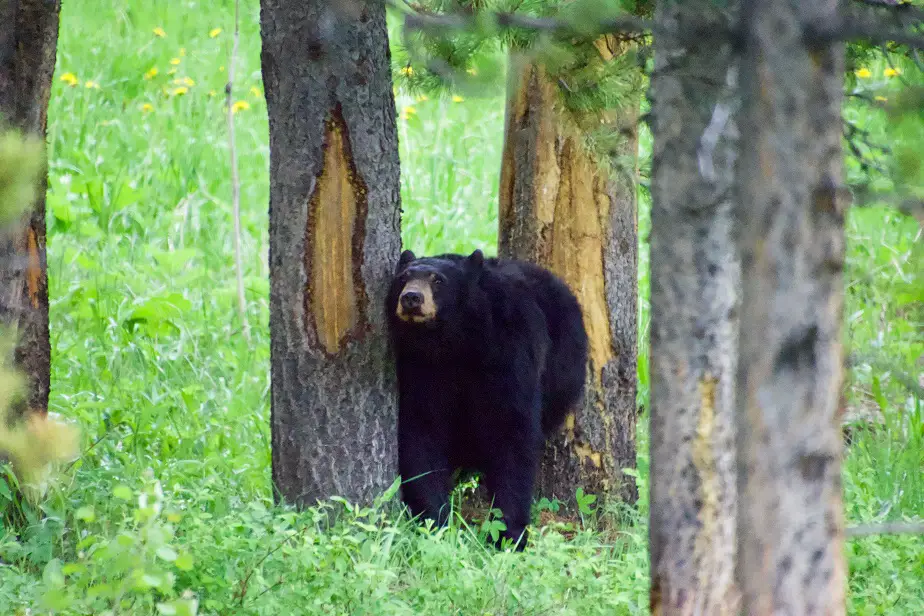My dad gave me a used 12-gauge shotgun for my 14th birthday. In my first year, I killed dozens of ducks and three whitetail deer. I have carried it in and out of the northern bear country for 16 years now.
12 gauge shotgun slugs are great bear loads. A 12-gauge shotgun has enough energy and penetration to reliably kill a bear up to 100 yards, depending on ammo. The right rifled and sabot slugs can be adequate. Brenneke makes the best traditional slugs for bear.
A 12-gauge shotgun is an incredibly powerful weapon, but its effectiveness is greatly limited by the type of bullets it shoots. Even among slugs, there are multiple types with different actions and properties. Some will work, others will not. Do you know which one you’d pick for a bear?

Why not 12-Guage Buckshot for Bears?
Buckshot lacks the penetration necessary to reliably kill a bear. You should not hunt bear with any buckshot. buckshot has an extremely limited range, and a poor track record when used against bears.
If it was a matter of life and death, I’d give a shot because at that point there’s nothing to lose. Basically, buckshot is too lightweight to have any effectiveness. The largest buckshot is 000. A pellet of 000 buckshot is 36 caliber and weighs 68 grains.
68 grains is light and the spherical shape of buckshot means a low sectional density as well. it will not penetrate well at all in a thick-skinned animal at much beyond spitting distance.
The pellets of 000 buckshot are comparable to a 308acp. In fact, the 380acp will penetrate slightly more than 000 buckshot because of its, you guessed it, sectional density. Would you feel comfortable that a 380acp would rive deep enough and hard enough to take out a tough bruin? If so, rethink things.
You may think that since there are multiple pellets in buckshot, it’d be alright. It’d be almost like shooting a bear with twelve 380acp bullets at the same time, right? Sort of, but that’s still no good. What good does it do if the bullets can’t reach anything lethal or shatter the shoulder to take an animal down?
You are far better off shooting a slug. If aiming with a slug is a problem, you should consider getting a rifled barrel that comes with a scope mount, or getting a rail mounted on your smoothbore shotgun.
12 Gauge Slugs for Bear Hunting
12-Gauge slugs can be a perfect bear hunting option. They are very powerful and some have excellent penetration capabilities. Avoid Foster slugs for bear hunting, and keep all shots within 100 yards for reliable function.
A slug is a single large bullet fire out of a shotgun There are 2 primary types of slugs. You have rifled slugs and sabot slugs. Both can be alright options for bear hunting, but there are major differences in their construction and ballistics.
Slugs are the poor man’s rifle. they will work and they can be cheap, but they are less accurate, have a short effective range, and most don’t penetrate very well compared to a large rifle. They also have a tremendous amount of recoil.
The most powerful is a heavy rifled slug, but it slows down significantly past 50 yards. If you are shooting farther than 100 yards, I would recommend a heavy sabot. Sabot slugs start faster and don’t slow down as quickly as rifled slugs.
The longer profile of a sabot gives them a higher ballistic coefficient. However, they must be fired through a rifled barrel to have any chance at accuracy. If a sabot is fired through a smooth bore, it will tumble and flip flop through the air even at very close distances.

12 Gauge Sabot Slugs for Bear
A heavy 12-gauge sabot will work well on a bear up to 150 yards away in practically every situation. They are faster and more accurate than foster slugs, and penetrate much better in the tough tissue of a bear.
Sabot slugs are fairly new on the scene compared to rifled slugs but it’s been a while now. A sabot is a smaller bullet in a plastic sleeve that’s loaded into the shotshell. Because it’s smaller in diameter, it’s usually lighter. That means it’s faster.
Sabot slugs are designed to only be fired from a rifled shotgun barrel. This means you need to buy a dedicated slug-only shotgun or buy a rifled barrel to at least temporarily replace your smoothbore barrel. A rifled barrel should either come with iron sights or a scope mount.
sabots are significantly more expensive than rifled slugs. But they work well. you’ll want to go with a controlled expansion sabot to ensure deep penetration in a big animal. don’t use a sabot that is designed for deer hunting. Unfortunately, most of them are.
The common speed for a 300 grain 12-gauge sabot is 2000 feet per second. Some are as fast as 2200 fps. The extra 400-800 feet per second adds more distance before the bullet is affected by gravity. Sabot slugs are also capable of holding a much more aerodynamic shape.
The aerodynamics (high sectional density) allowed by the sabot design gives us a bullet that not only shoots flatter but penetrates very well too. This gives the shooter more maximum effective range, up to 200 yards. some sabots are similar weights to a rifled slug, but they need a taller shell to hold it. A 3-inch shell can hold a sabot of about the same weight as a 2 ¾ with a rifled slug.

12 Gauge Rifled Slugs for Bear
Before I go any farther, I will let you in a secret. Rifled slugs aren’t actually rifled. The term “rifled slug” was originally a marketing ploy. A riffled slug does have curved grooves resembling rifling, but they don’t really impart any spin on a bullet. Believe it or not, it’s true.
Originally, they hoped it would work, but it didn’t. it was found that the groves help the slug to mash down if shot through a tight choke. A rifled slug doesn’t really spin as a rifle bullet does. Instead, it uses a design like a badminton birdie for stability.
The term “rifled slug” is a misnomer. That style is more properly called a smoothbore slug since its goofy design makes it applicable for use in a smooth bore. Firing out of a smooth bore, it’s more like a magnum musket than anything else really.
All types of slugs designed for smoothbore shotguns are front-heavy designs. The classic foster style slug has a thick round nose, but a thinner-walled, hollow back portion to keep it quite front heavy.
most decent shooters can only get a 10-inch group at 100 yards with rifled slugs in a smooth barrel. If you use a rifled barrel, you can shrink that down in half.
Rifled slugs are heavier than sabots but are slower and less accurate. They are also less aerodynamic. The aerodynamics of a rifled slug means that it has a shorter effective range. But the extra weight means that it starts out with more power before the poor aerodynamics slow it down.
Rifled slugs come in two options. Hollow-base slugs, also called Foster-style, and solid slugs. The foster-style slug has been around a long time. It’s a classic, that says something. Foster slugs have killed a lot of deer, and no doubt, bears too, but I wouldn’t suggest them for big animals like bears.
Let’s take a closer look at the different types of rifled slugs.
Foster Style Rifled Slugs
A foster-type slug looks like a small lead cup that’s because it basically is. A big part of the killing potential of a bullet is its sectional density. Foster slugs have an incredibly poor sectional density. That means it sheds its energy quickly and doesn’t penetrate an animal well.
The hollow design of these slugs allows them to deform more than you might expect. They can flatten out to almost a disk, which causes a wider wound but doesn’t allow as deep of penetration. Because of this, they are loaded to a maximum velocity of 1600 feet per second.
If they go much faster, they will experience major deformation in a short wound but won’t penetrate as it should. This is increased by the fact that they are usually made of soft lead (pure lead). Soft lead makes cheap slugs, but it can’t hold up to velocities over 1600 feet per second.
Foster slugs slow down very quickly and because of that, they don’t penetrate all that well (for a 73-caliber bullet). Even so, due to the high levels of power, they seem to be effective on animals under 400 pounds within their effective maximum range. the maximum range of a foster slug is 100 yards on deer, and closer to 50 for a mid-sized bear.
Really though, if you are going to use a slug for bears, I recommend you not use a foster, and still keep it within 50 yards. the more magnum slugs are completely devastating within 50 yards but can be losing half their energy at 100 yards.
Solid slugs
Besides the foster design, there are several more solid-designed non-sabot slugs that are much more suited for bears. These are mostly made by boutique ammo manufactures and may be a special-order item at your local gun store.
These more solid slugs are still front-heavy. Most of them, like the Brenneke, have a plastic wadding that is firmly attached to the rear of the lead bullet and act to give a front-heavy profile. Which keeps it pointed in the right direction during a flight.
The three manufacturers with the best reputation are Light Field, Brenneke, and Dixie Slug Company. Light Field used to make a 3 ½ inch 12-gauge slug pushing a bullet over 700 grains to nearly 1600 fps. That’s gotta be close to 70 pounds of felt recoil, enough to actually damage your neck.
Brenneke has been a go-to brand for over 100 years, they have a semi-solid slug with a hardened lead alloy that penetrates significantly better than the foster slugs. Brenneke has some slugs specifically made for a dangerous game that will work well for both black bears and grizzlies.
Their magnum line of slugs is nothing to talk down about. Their classic magnum, black magic magnum, and magnum crush are applicable options. I like the black magic and the magnum crush for bear hunting. Brenneke slugs seem to be some of the more accurate rifled slugs in the market too.
Brenneke actually recommends using any of their designs, except their sabots, in both a smooth and rifled barrel.
Dixie Slug Company only makes dangerous game loads for shotguns. Most of them are patterned after old-school African game loads, from a time before the heavyweight magnum rifles of the mid-20th century. They take pride in producing hard-hitting, massive slugs with good penetration, specifically designed for sopping dangerous game with a trusty old shotgun.
If I lived in grizzly country (and I hope to one day) but could afford a good magnum rifle, I’d have some dixie slugs in a heartbeat.
Please remember though, to keep the distance short. Keeping the distance short means getting close. Getting close means, it can turn dangerous more quickly. Shotgunning for bear is not preferred but it can be done well if need be. The poor man’s rifle, aka slugs, will work if you need it to.

